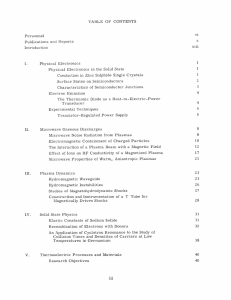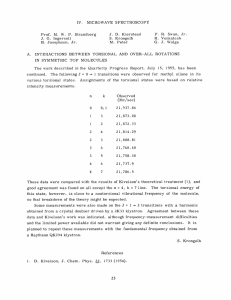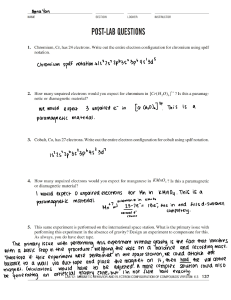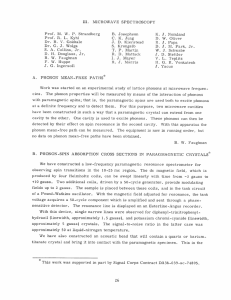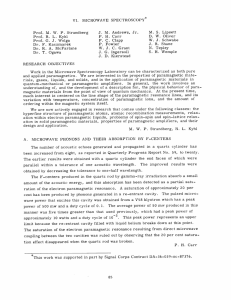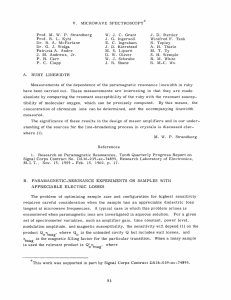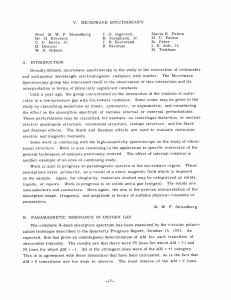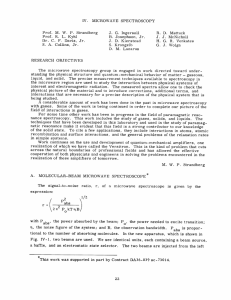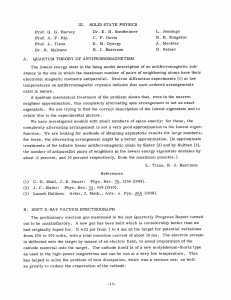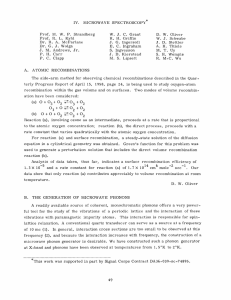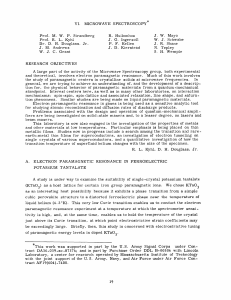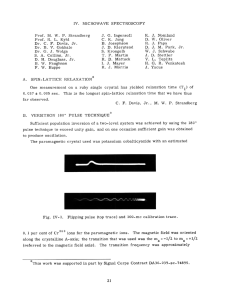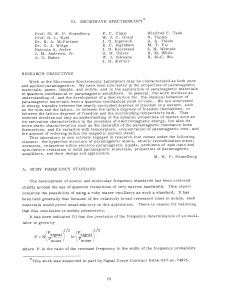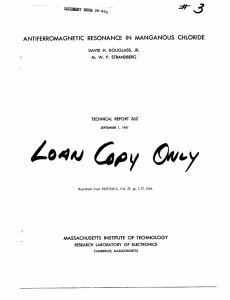VII. MICROWAVE SPECTROSCOPY D. W. Oliver Strandberg
advertisement
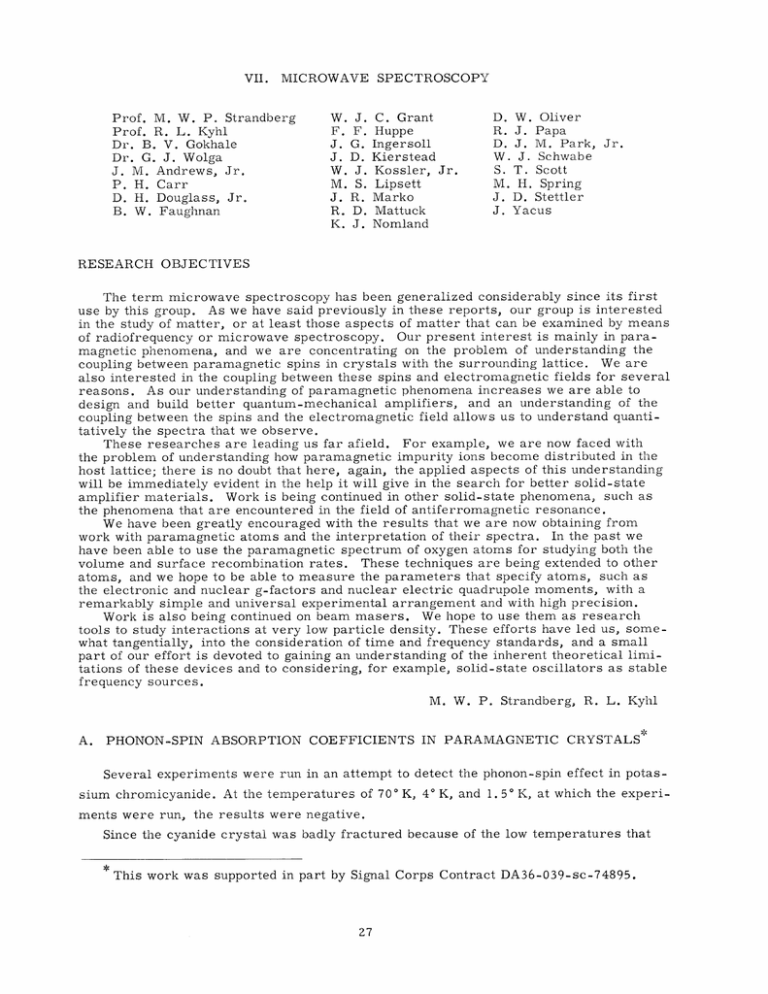
VII. MICROWAVE Prof. M. W. P. Strandberg Prof. R. L. Kyhl Dr. B. V. Gokhale Dr. G. J. Wolga J. M. Andrews, Jr. P. H. Carr D. H. Douglass, Jr. B. W. Faughnan W. F. J. J. W. M. J. R. K. J. F. G. D. J. S. R. D. J. SPECTROSCOPY C. Grant Huppe Ingersoll Kierstead Kossler, Jr. Lipsett Marko Mattuck Nomland D. R. D. W. S. M. J. J. W. Oliver J. Papa J. M. Park, Jr. J. Schwabe T. Scott H. Spring D. Stettler Yacus RESEARCH OBJECTIVES The term microwave spectroscopy has been generalized considerably since its first use by this group. As we have said previously in these reports, our group is interested in the study of matter, or at least those aspects of matter that can be examined by means of radiofrequency or microwave spectroscopy. Our present interest is mainly in paramagnetic phenomena, and we are concentrating on the problem of understanding the coupling between paramagnetic spins in crystals with the surrounding lattice. We are also interested in the coupling between these spins and electromagnetic fields for several reasons. As our understanding of paramagnetic phenomena increases we are able to design and build better quantum-mechanical amplifiers, and an understanding of the coupling between the spins and the electromagnetic field allows us to understand quantitatively the spectra that we observe. These researches are leading us far afield. For example, we are now faced with the problem of understanding how paramagnetic impurity ions become distributed in the host lattice; there is no doubt that here, again, the applied aspects of this understanding will be immediately evident in the help it will give in the search for better solid-state amplifier materials. Work is being continued in other solid-state phenomena, such as the phenomena that are encountered in the field of antiferromagnetic resonance. We have been greatly encouraged with the results that we are now obtaining from work with paramagnetic atoms and the interpretation of their spectra. In the past we have been able to use the paramagnetic spectrum of oxygen atoms for studying both the volume and surface recombination rates. These techniques are being extended to other atoms, and we hope to be able to measure the parameters that specify atoms, such as the electronic and nuclear g-factors and nuclear electric quadrupole moments, with a remarkably simple and universal experimental arrangement and with high precision. Work is also being continued on beam masers. We hope to use them as research tools to study interactions at very low particle density. These efforts have led us, somewhat tangentially, into the consideration of time and frequency standards, and a small part of our effort is devoted to gaining an understanding of the inherent theoretical limitations of these devices and to considering, for example, solid-state oscillators as stable frequency sources. M. A. W. P. Strandberg, R. L. Kyhl PHONON-SPIN ABSORPTION COEFFICIENTS IN PARAMAGNETIC CRYSTALS Several experiments were run in an attempt to detect the phonon-spin effect in potassium chromicyanide. At the temperatures of 70 0 K, 4 0 K, and 1. 5 K, at which the experi- ments were run, the results were negative. Since the cyanide crystal was badly fractured because of the low temperatures that This work was supported in part by Signal Corps Contract DA36-039-sc-74895. (VII. MICROWAVE SPECTROSCOPY) were used, we believe that the probable source of difficulty was poor phonon conduction. We decided, therefore, to use ruby as the paramagnetic specimen in further work because it usually has nearly perfect lattice structure and consequent high acoustic conductivity. A ruby cylinder, 1. 5 inches long and 3/8 inch in diameter, was cut from a synthetic boule. Similar experiments were performed but no acoustic effect was observed. We then made a theoretical analysis. required phonon-energy density of 10 - 8 10 . 10 It indicated that our previous estimate of the ergs/cm 3 may have been too low by a factor of Since the sound-energy density in the experiment was probably in the vicinity of - 3 ergs/cm 3 , steps are being taken to increase the acoustic input by using a matching network between signal generator and quartz oscillator and possibly by introducing a power amplifier. This should increase the phonon density by a factor of approximately 102 and make the effect observable. R. D. Mattuck B. SPECTROSCOPY OF FREE ATOMS The hyperfine structure of free atomic method of paramagnetic resonance. chlorine was observed at X-band by the Gaseous chlorine at a pressure of a few millimeters of mercury was dissociated in an S-band microwave discharge and flowed through the detection cavity of the X-band spectrometer. The observed transitions corresponded to AM. = ±1 and AM. = 0 for both stable chlorine isotopes. j i with a signal-to-noise ratio of 10-100; The spectra were obtained the ratio depends upon the operating pressure. Further experiments are in progress to improve the resolution and to obtain accurate gj values for both isotopes. G. J. C. Wolga ANTIFERROMAGNETIC RESONANCE IN ANHYDROUS MANGANESE CHLORIDE (MnC12) The spectrum of single-crystal MnC1Z at K-A band (35 kmc) is very nearly complete. It is indicated in Fig. VII-1. C-axis. ropy. There appears to be no anisotropy for rotations about the For rotations about an axis normal to the C-axis, there is considerable anisot(See Fig. VII-2.) Points A and B in both figures represent the same temperature and orientation of the crystal. Our data cannot be explained by the simple theory of antiferromagnetic resonance (i. e., the simple theory predicts no deviation from perature Tc ). 2c g = 2 above the critical tem- Qualitatively, the deviations in the data are attributable to the (VII. MICROWAVE 12 LINE FOR g = 2 12.0 _- SPECTROSCOPY) 0 10.0 - o 80- a 60 I I- 6 z 4.0 Tc z Tc I 2 TEMPERATURE 4 cn cr Fig. VII-1. a 2 3 (oK) Resonant field (H) versus temperature for H perpendicular to the C-axis. Fig. VII-2. Resonant field (H) versus angle (between H and Caxis). The spins are strongly constrained to lie in a plane normal to the C-axis, and within this plane the spins are nearly free to rotate. The data short-range order of the system (1). have not yet been explained quantitatively. D. H. Douglass, Jr. References 1. D. H. Douglass, Jr., Antiferromagnetic resonance, Quarterly Progress Report No. 51, Research Laboratory of Electronics, M.I.T., Oct. 15, 1958, p. 47.
